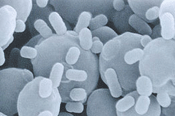| Overview | Team | Publications | Presentations | Resources | Contact | Links | GenomeBC |
Resources |
 |
||
ProtocolsA description of many of the protocols implemented in the PI2 project is hosted at the Hancock Lab Website. SoftwareFreely available software used in and developed by members of the PI2 project includes: Cerebral, developed by Aaron Barsky and Jennifer Gardy as part of the PI2 project, is a plugin for the open-source Cytoscape biomolecular interaction viewer. It uses subcellular localization and functional information to automatically generate a more pathway-like layout of a network diagram. Cerebral is available at http://www.pathogenomics.ca/cerebral and is described in the manuscript Barsky A, Gardy JL, Hancock REW, Munzner T. Cerebral: a Cytoscape plugin for layout of and interaction with biological networks using subcellular localization annotation. Bioinformatics 2007 Apr 15;23(8):1040-2. PMID: 17309895 ArrayPipe, developed by Karsten Hokamp as part of the FPMI project, is a web-based or standalone tool for the processing and analysis of microarray data. It provides functions for data visualization, background correction, normalization, detections of differentially expressed genes, comparison and highlighting of gene lists, as well as web-based spreadsheets for data mining. ArrayPipe is available at http://www.pathogenomics.ca/arraypipe and is described in the manuscript Hokamp K, Roche FM, Acab M, Rousseau ME, Kuo B, Goode D, Aeschliman D, Bryan J, Babiuk LA, Hancock RE, Brinkman FS. ArrayPipe: a flexible processing pipeline for microarray data. Nucleic Acids Res. 2004 Jul 1;32(Web Server issue):W457-9. PMID: 15215429 ProbeLynx, developed by Fiona Roche as part of the FPMI project, is a web-based tool for updating the association of microarray probes to genes. using the latest genomics sequence information and experimentally determined cross-hybridization cutoffs, ProbeLynx allows users to upload microarray probe sequences to re-examine probe specificity and provide annotation updates relevant to determining which gene(s) and transcript(s) are associated with a given probe. ProbeLynx is available at http://www.pathogenomics.ca/probelynx and is described in the manuscript Roche FM, Hokamp K, Acab M, Babiuk LA, Hancock RE, Brinkman FS. ProbeLynx: a tool for updating the association of microarray probes to genes. Nucleic Acids Res. 2004 Jul 1;32(Web Server issue):W471-4. PMID: 15215432 Ortholuge is a computational method that can generate precise ortholog predictions between two species on a genome-wide scale (using additional outgroup data for reference). It can either evaluate a previously constructed set of orthologs or it can generate an initial tentative set of orthologs that are subsequently evaluated. Precise ortholog prediction is important for a variety of analyses that utilize comparative genomics, including regulatory element identification. We developed this method to aid our comparative analyses for this pathogenomics project, though the software is freely available under an open source licence for use by others at http://www.pathogenomics.ca/ortholuge/. Ortholuge is described in the manuscript Fulton DL, Li YY, Laird M, Horsman BGS, Roche FM, Brinkman FSL. Improving the specificity of high-throughput ortholog prediction. BMC Bioinformatics. 2006 May 28;7:270.
|
|||




